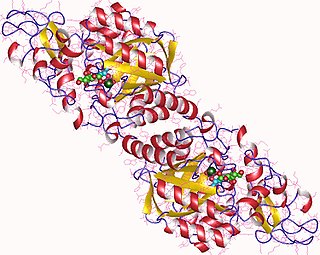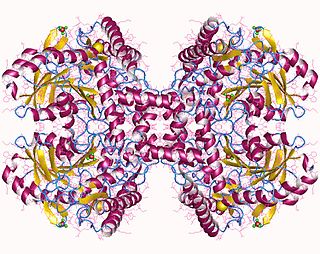
Selenocysteine is the 21st proteinogenic amino acid. Selenoproteins contain selenocysteine residues. Selenocysteine is an analogue of the more common cysteine with selenium in place of the sulfur.

In biochemistry, a transferase is any one of a class of enzymes that catalyse the transfer of specific functional groups from one molecule to another. They are involved in hundreds of different biochemical pathways throughout biology, and are integral to some of life's most important processes.

Molybdopterins are a class of cofactors found in most molybdenum-containing and all tungsten-containing enzymes. Synonyms for molybdopterin are: MPT and pyranopterin-dithiolate. The nomenclature for this biomolecule can be confusing: Molybdopterin itself contains no molybdenum; rather, this is the name of the ligand that will bind the active metal. After molybdopterin is eventually complexed with molybdenum, the complete ligand is usually called molybdenum cofactor.
In enzymology, a putrescine carbamoyltransferase is an enzyme that catalyzes the chemical reaction
In enzymology, a glutathionylspermidine synthase is an enzyme that catalyzes the chemical reaction
In enzymology, a homoglutathione synthase is an enzyme that catalyzes the chemical reaction
In enzymology, a glutathione gamma-glutamylcysteinyltransferase is an enzyme that catalyzes the chemical reaction
In enzymology, a formaldehyde transketolase is an enzyme that catalyzes the chemical reaction
In enzymology, a N2-(2-carboxyethyl)arginine synthase (EC 2.5.1.66) is an enzyme that catalyzes the chemical reaction

In enzymology, a N-acetylneuraminate synthase (EC 2.5.1.56) is an enzyme that catalyzes the chemical reaction
In enzymology, a dolichyl-phosphate beta-D-mannosyltransferase is an enzyme that catalyzes the chemical reaction
In enzymology, an UDP-N-acetylglucosamine—dolichyl-phosphate N-acetylglucosaminephosphotransferase is an enzyme that catalyzes the chemical reaction
In enzymology, a selenide, water dikinase (EC 2.7.9.3) is an enzyme that catalyzes the chemical reaction
In enzymology, a serine-phosphoethanolamine synthase is an enzyme that catalyzes the chemical reaction

5-enolpyruvylshikimate-3-phosphate (EPSP) synthase is an enzyme produced by plants and microorganisms. EPSPS catalyzes the chemical reaction:
O-phospho-L-seryl-tRNA:Cys-tRNA synthase is an enzyme with systematic name O-phospho-L-seryl-tRNACys:hydrogen sulfide 2-aminopropanoate transferase. This enzyme catalyses the following chemical reaction
O-phosphoseryl-tRNASec kinase is an enzyme with systematic name ATP:L-seryl-tRNASec O-phosphotransferase. This enzyme catalyses the following chemical reaction

O-phospho-L-seryl-tRNASec:L-selenocysteinyl-tRNA synthase is an enzyme with systematic name selenophosphate:O-phospho-L-seryl-tRNASec selenium transferase. This enzyme catalyses the following chemical reaction
A selenotransferase is a transferase enzyme that act upon atoms of selenium.







